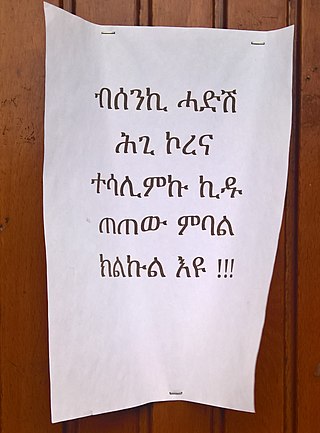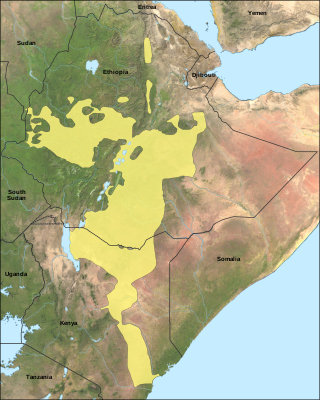Related Research Articles

The Omotic languages are a group of languages spoken in southwestern Ethiopia, in the Omo River region and southeastern Sudan in Blue Nile State. The Geʽez script is used to write some of the Omotic languages, the Latin script for some others. They are fairly agglutinative and have complex tonal systems. The languages have around 7.9 million speakers. The group is generally classified as belonging to the Afroasiatic language family, but this is disputed by some.

Tigrinya is an Ethio-Semitic language commonly spoken in Eritrea and in northern Ethiopia's Tigray Region by the Tigrinya and Tigrayan peoples. It is also spoken by the global diaspora of these regions.
Amharic is an Ethiopian Semitic language, which is a subgrouping within the Semitic branch of the Afroasiatic languages. It is spoken as a first language by the Amharas, and also serves as a lingua franca for all other populations residing in major cities and towns in Ethiopia.

Oromo, historically also called Galla, is an Afroasiatic language that belongs to the Cushitic branch. It is native to the Ethiopian state of Oromia and Northern Kenya and is spoken predominantly by the Oromo people and neighboring ethnic groups in the Horn of Africa. It is used as a lingua franca particularly in the Oromia Region and northeastern Kenya.

Sandawe is a language spoken by about 60,000 Sandawe people in the Dodoma Region of Tanzania. Sandawe's use of click consonants, a rare feature shared with only two other languages of East Africa – Hadza and Dahalo, had been the basis of its classification as a member of the defunct Khoisan family of Southern Africa since Albert Drexel in the 1920s. Recent investigations however suggest that Sandawe may be related to the Khoe family regardless of the validity of Khoisan as a whole. A discussion of Sandawe's linguistic classification can be found in Sands (1998).
Bench is a Northern Omotic language of the "Gimojan" subgroup, spoken by about 174,000 people in the Bench Maji Zone of the Southern Nations, Nationalities, and Peoples Region, in southern Ethiopia, around the towns of Mizan Teferi and Shewa Gimira. In a 2006 dissertation, Christian Rapold described three varieties of Bench as "...mutually intelligible...varieties of one and the same language". Bench is the ancestral language of the Bench people.
Danish grammar is either the study of the grammar of the Danish language, or the grammatical system itself of the Danish language. Danish is often described as having ten word classes: verbs, nouns, pronouns, numerals, adjectives, adverbs, articles, prepositions, conjunctions, and interjections. The grammar is mostly suffixing. This article focuses on Standard Danish.
Anfillo is a Northern Omotic language spoken in western Ethiopia by a few hundred people. The term Anfillo is used to refer both to the language and the people found in a small community in the Anfillo woreda, part of the Mirab Welega Zone. The language is on the verge of extinction as it is spoken only by adults above the age of sixty. All younger generations have shifted to Western Oromo as of 2007.
Argobba is an Ethiopian Semitic language spoken in several districts of Afar, Amhara, and Oromia regions of Ethiopia by the Argobba people. It belongs to the South Ethiopic languages subgroup, and is closely related to Amharic.
The Awngi language, in older publications also called Awiya, is a Central Cushitic language spoken by the Awi people, living in Central Gojjam in northwestern Ethiopia.
The Qimant language is a highly endangered language spoken by a small and elderly fraction of the Qemant people in northern Ethiopia, mainly in the Chilga woreda in Semien Gondar Zone between Gondar and Metemma.
Dirasha is a member of the Cushitic branch of the Afro-Asiatic family. It is spoken in the Omo region of Ethiopia, in the hills west of Lake Chamo, around the town of Gidole.
Arbore is an Afro-Asiatic language spoken by the Arbore people in southern Ethiopia in a few settlements of Hamer woreda near Lake Chew Bahir.
Baiso or Bayso is an Afro-Asiatic, more specifically a Lowland East Cushitic language belonging to the Omo-Tana subgroup, and is spoken in Ethiopia, in the region around Lake Abaya.
Chara is an Afro-Asiatic language of the North Omotic variety spoken in the Southern Nations, Nationalities, and People's Region of Ethiopia by 13,000 people.
Gamo-Gofa-Dawro is an Omotic language of the Afroasiatic family spoken in the Dawro, Gamo Gofa and Wolayita Zones of the Southern Nations, Nationalities, and Peoples' Region in Ethiopia. Varieties are spoken by the Gamo, Gofa, Dawro; Blench (2006) and Ethnologue treat these as separate languages. Zala presumably belongs here as well. Dialects of Dawro (Kullo-Konta) are Konta and Kucha. In 1992, Alemayehu Abebe collected a word-list of 322 entries for all three related dialects.
Sheko is an Omotic language of the Afro-Asiatic language family spoken in the area between Tepi and Mizan Teferi in western Ethiopia, in the Sheko district in the Bench Maji Zone. The 2007 census lists 38,911 speakers; the 1998 census listed 23,785 speakers, with 13,611 identified as monolinguals.
Nayi is an Omotic language of the Afro-Asiatic language family spoken in western Ethiopia. Most of the speakers of the language live in two separated areas. The largest grouping live in Decha woreda of the Keffa Zone. The nearest city to their region is Bonga. A few in Dulkuma village of the Shoa Bench woreda, some in Sheko woreda having moved there in 1976-1977 as a result of conflicts between local feudal lords and the military government. In Decha, young people no longer speak the language.
Komo is a Nilo-Saharan language spoken by the Kwama (Komo) people of Ethiopia, Sudan and South Sudan. It is a member of the Koman languages. The language is also referred to as Madiin, Koma, South Koma, Central Koma, Gokwom and Hayahaya. Many individuals from Komo are multilingual because they are in close proximity to Mao, Kwama and Oromo speakers. Komo is closely related to Kwama, a language spoken by a group who live in the same region of Ethiopia and who also identify themselves as ethnically Komo. Some Komo and Kwama speakers recognize the distinction between the two languages and culture, whereas some people see it as one "ethnolinguistic" community. The 2007 Ethiopian census makes no mention of Kwama, and for this reason its estimate of 8,000 Komo speakers may be inaccurate. An older estimate from 1971 places the number of Komo speakers in Ethiopia at 1,500. The Komo language is greatly understudied; more information is being revealed as researchers are discovering more data about other languages within the Koman family.
The Chara also known as the Tsara are a people group of Ethiopia. They form a part of the Gimira peoples of Ethiopia and live in the Kaffa Highlands, and the Debub Omo area.
References
- 1 2 Dime at Ethnologue (18th ed., 2015) (subscription required)
- 1 2 Seyoum, Mulugeta (2008). A grammar of Dime (Ph.D. thesis). Leiden University. hdl: 1887/12833 .
- ↑ Fleming, Harold (1990). Richard Hayward (ed.). Omotic Language Studies. London: SOAS. p. 495. ISBN 9780728601666.
- ↑ 1994 Population and Housing Census of Ethiopia: Results for Southern Nations, Nationalities and Peoples' Region, Vol. 1, part 1, Table 2.14
- ↑ Central Statistical Agency. "Ethiopia - Population and Housing Census 2007 Report, National". International Household Survey Network.